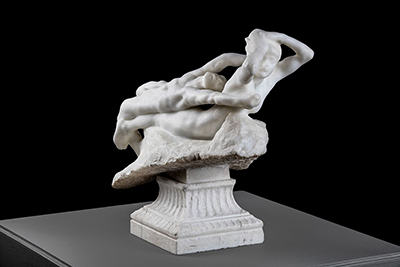Fugitive Love sculpture by Auguste Rodin completed between the year 1886 and 1887 was made using marble and then cast in bronze. The sculpture is part of the artist's group of sculptures called the Gates of Hell. It was placed at the right gate of the monument to replace Kiss which was inconsistent with the theme of the rest of the sculptures.
Rodin got the inspiration to create the piece from Dante Alighieri's poetry which created an illusion of lust. The poem described two characters Paolo Malatesta and Francesca da Ramini who had a forbidden love affair. Auguste Rodin's sculpture shows a man and a woman. The woman is trying to escape into the air while the man tries to reach out to her. Clearly, the love is not meant to be and probably will never happen; hence the name, Fugitive Love. Rodin also got inspiration from his wife Camille Claudel who taught him about art and also admired his work.
The artwork first appeared for exhibition in 1887 in the Georges Petit gallery. The two-figure group first showcased under the names The Dream and The Sphinx. Gustave Geffroy, an art critic, then discovered it. The sculpture appeared again in the same gallery in 1889. After that, it became so popular that it was later reproduced but now using white marble and bronze. Just like Auguste's other artworks, Fugitive Love was created using the technique of adding, subtracting, or even multiplying. He would add or remove limbs until he came out with the final piece. No wonder then, that his sculptures were so successful. Since then, some sculptures of Fugitive Love have been made using bronze and others moulded using marble. The sizes of the art pieces differ such that some can fit in a collector’s gallery.
The main contributing factor of the success of Fugitive Love is that it precisely represented the struggles of Rodin's generation. Most people had fantasies and problems to do with their love and relationships. Currently, several versions of the artwork exist, and they still depict the same message. Most importantly, Rodin ensured that he worked on the surfaces and the contours of his sculptures. He believed that fine and well-polished surfaces had more impact on the viewers.
The sculptors's predecessors created sculptures that mainly spoke about history and religion. With Fugitive Love, the piece triggered different emotions and imagination in the minds of the viewers. His work has been an inspiration to many artists after him. Without a doubt, Fugitive Love acted as a link between modern and traditional artwork. Museo Soumaya Museum in Mexico holds the original art where admirers can view.




